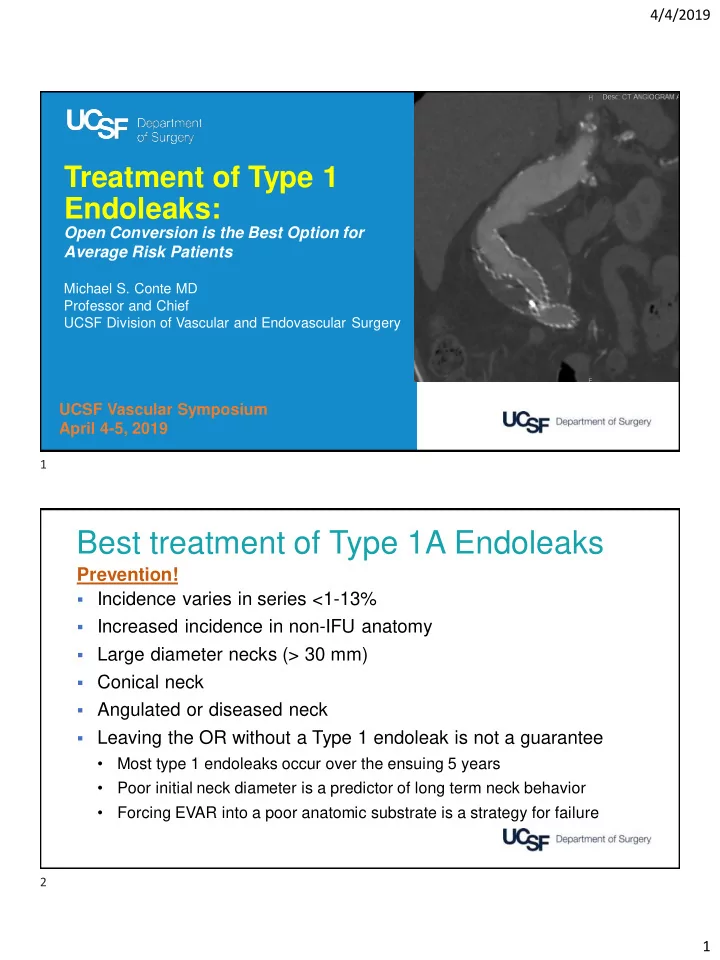

4/4/2019 Treatment of Type 1 Endoleaks: Open Conversion is the Best Option for Average Risk Patients Michael S. Conte MD Professor and Chief UCSF Division of Vascular and Endovascular Surgery UCSF Vascular Symposium April 4-5, 2019 1 Best treatment of Type 1A Endoleaks Prevention! ▪ Incidence varies in series <1-13% ▪ Increased incidence in non-IFU anatomy ▪ Large diameter necks (> 30 mm) ▪ Conical neck ▪ Angulated or diseased neck ▪ Leaving the OR without a Type 1 endoleak is not a guarantee • Most type 1 endoleaks occur over the ensuing 5 years • Poor initial neck diameter is a predictor of long term neck behavior • Forcing EVAR into a poor anatomic substrate is a strategy for failure 2 1
4/4/2019 VQI >14,000 EVAR with 1-year imaging data Overall: 25% Sac Expansion J Vasc Surg 2019; 69(414-22) 3 JVIR 2018; 29:1011-16 4 2
4/4/2019 Type 1A Endoleak Treatment Options Endovascular Open Repair ▪ Extension cuff/stent with or ▪ Supra-renal or supra-celiac without snorkels etc clamping ▪ Endoanchors ▪ Trans-abdominal vs RP approach ▪ ZFEN conversion ▪ Higher risk than initial ▪ MBEG conversion elective repair (4-27% 30 day mortality) 5 • 86 yo M, s/p EVAR 2010 for 5.6 cm AAA • Medtronic Talent 32 mm main body • Enlarged to 8.2 cm 2016 • Type 1A endoleak • Juxtarenal AAA • Former smoker, mild COPD • Active, high functioning UCSF Center for Aortic Disease 6 3
4/4/2019 Open Conversion Transperitoneal exposure. - Proximal control supra-celiac, distal control of bilateral iliac limbs. - Explant main body, transect iliac limbs. - Proximal anastomosis at level of renals. - Distal anastomoses to bilateral iliac limbs. - UCSF Center for Aortic Disease 7 Follow-up CTA 2 years post-conversion Pre-conversion UCSF Center for Aortic Disease 8 4
4/4/2019 • 77 yo F, s/p EVAR 2013 for 5.7 cm AAA • Medtronic Talent 28 mm main body • Enlarged to 8.2 cm 2016 • Type 1A endoleak • Juxtarenal AAA • Former smoker, no CAD • Stage 3 CKD • Active, high functioning • Reintervention 10/2016 for Type 1b leak (R iliac) • Coil Type 2 leak 6/2017 UCSF Center for Aortic Disease 9 Open Conversion Retroperitoneal exposure with partial 11 th rib resection. - - Left kidney down due to retro-aortic left renal vein. Proximal control between celiac and SMA, distal control b/l iliac limbs. - Explant main body, transect iliac limbs. - Proximal anastomosis at orifice of left renal (w/ limited endarterectomy). - Distal anastomoses to right graft limb and left external iliac. - UCSF Center for Aortic Disease 10 5
4/4/2019 • 71 yo M, s/p FEVAR 2015 • 32 mm main body, SMA scallop + 2 fenestrations • Type 1A endoleak in OR- cuff • Coil placement adjacent to LRA • Former smoker, no CAD • Active, high functioning • Sac increased to 6.1 cm UCSF Center for Aortic Disease 11 Open Conversion Transperitoneal exposure. - Proximal control supraceliac, distal control of bilateral common iliacs. - Transect stentgraft below left renal, transect iliac limbs. - 24 x 12 mm Dacron graft selected, 7 mm side branch created (for RRA) - - Proximal anastomosis to level of left renal, incorporating prior stentgraft. - Bypass to right renal with pre-fashioned 7 mm limb. - Distal anastomoses to bilateral iliac limbs (left CIA, right EIA). UCSF Center for Aortic Disease 12 6
4/4/2019 6 mo post-conversion CTA (video) UCSF Center for Aortic Disease 13 53% Type 1A endoleaks 30-day Mortality: 8.1% with graft explant; 3.6% no explant One year survival 87% J Vasc Surg 2018 (ePub) 14 7
4/4/2019 30 day mortality: 6.3% (3.8% for elective conversions) Increased iliac degeneration when limbs were removed J Vasc Surg 2019; 69(80-85) 15 J Vasc Surg 2016; 63(873-81) 16 8
4/4/2019 J Vasc Surg 2018; 68(1676-87) 17 J Vasc Surg 2018; 68(1676-87) 18 9
4/4/2019 Best treatment of Type 1A Endoleaks Take Home Points ▪ Elective re-intervention is far safer ▪ Both open conversion and endovascular interventions needed • Average risk patients may be better served by open conversion earlier, unless there is a high probability of success endo option in play • Open conversion, done electively, has marginally higher morbidity and mortality compared to primary open repair in experienced hands • A poor quality neck is best repaired open • Multiple failed endovascular interventions increases surgical complexity, and should be avoided in a surgical candidate- avoid the slippery slope 19 20 10
Recommend
More recommend